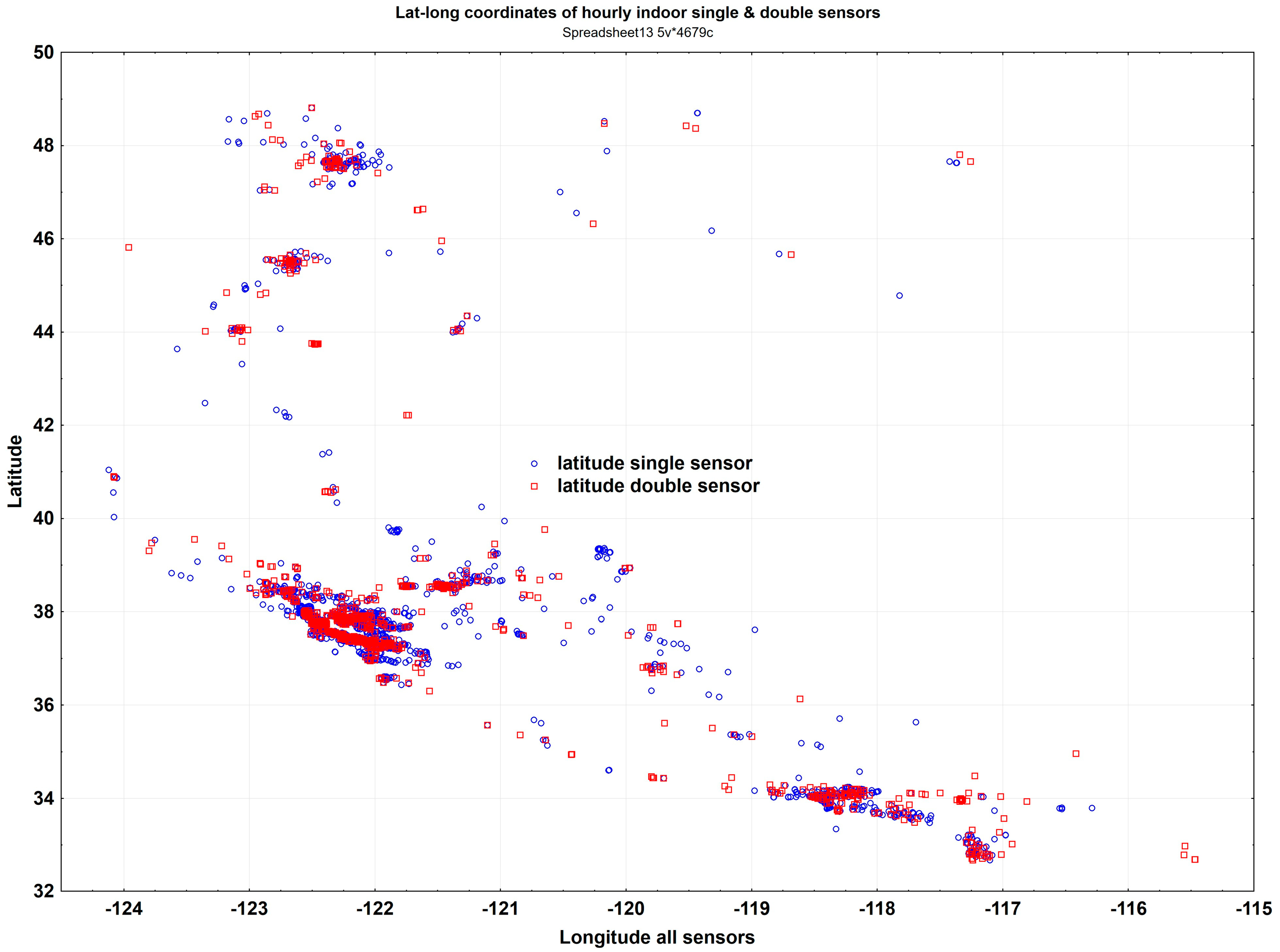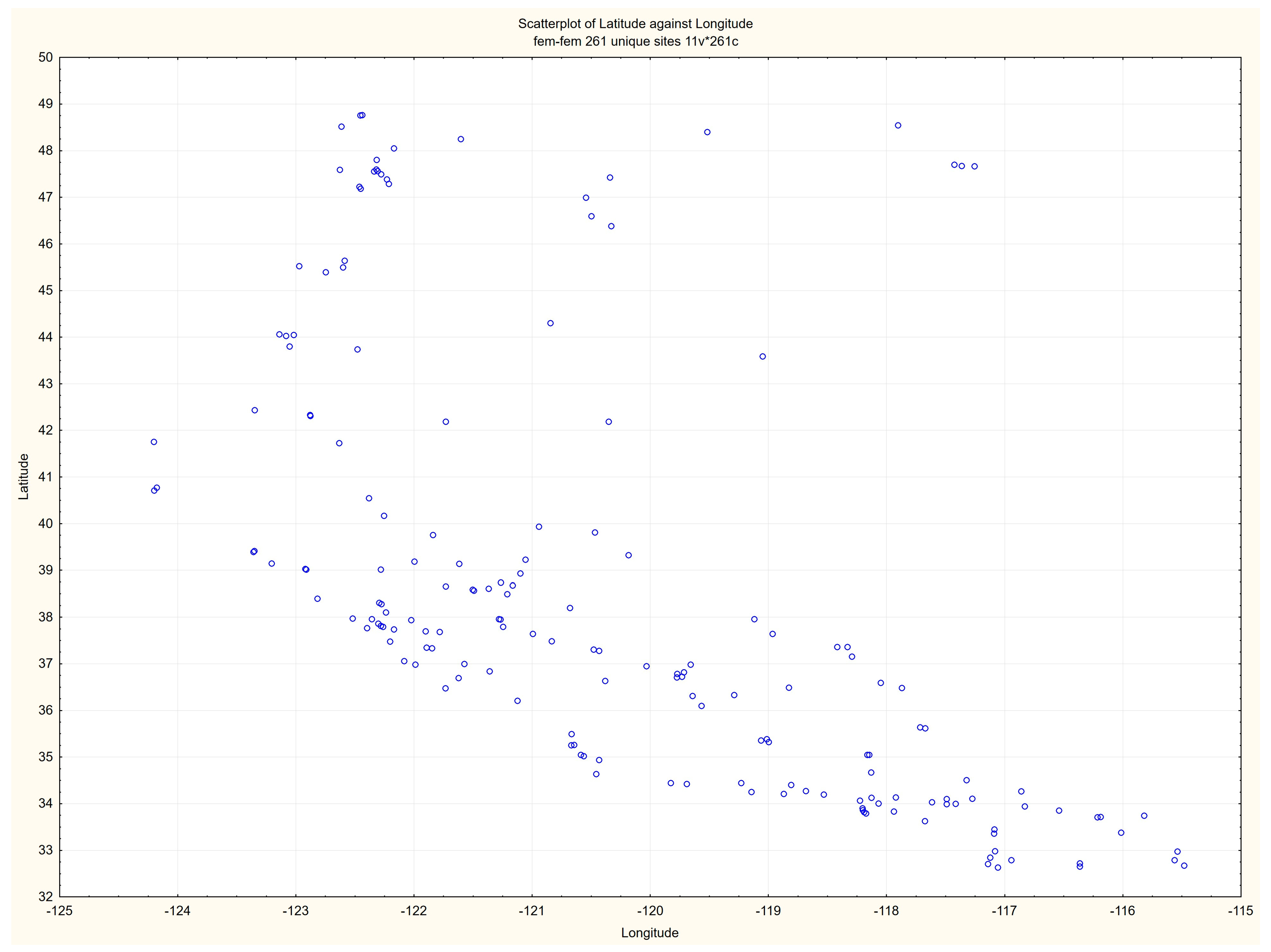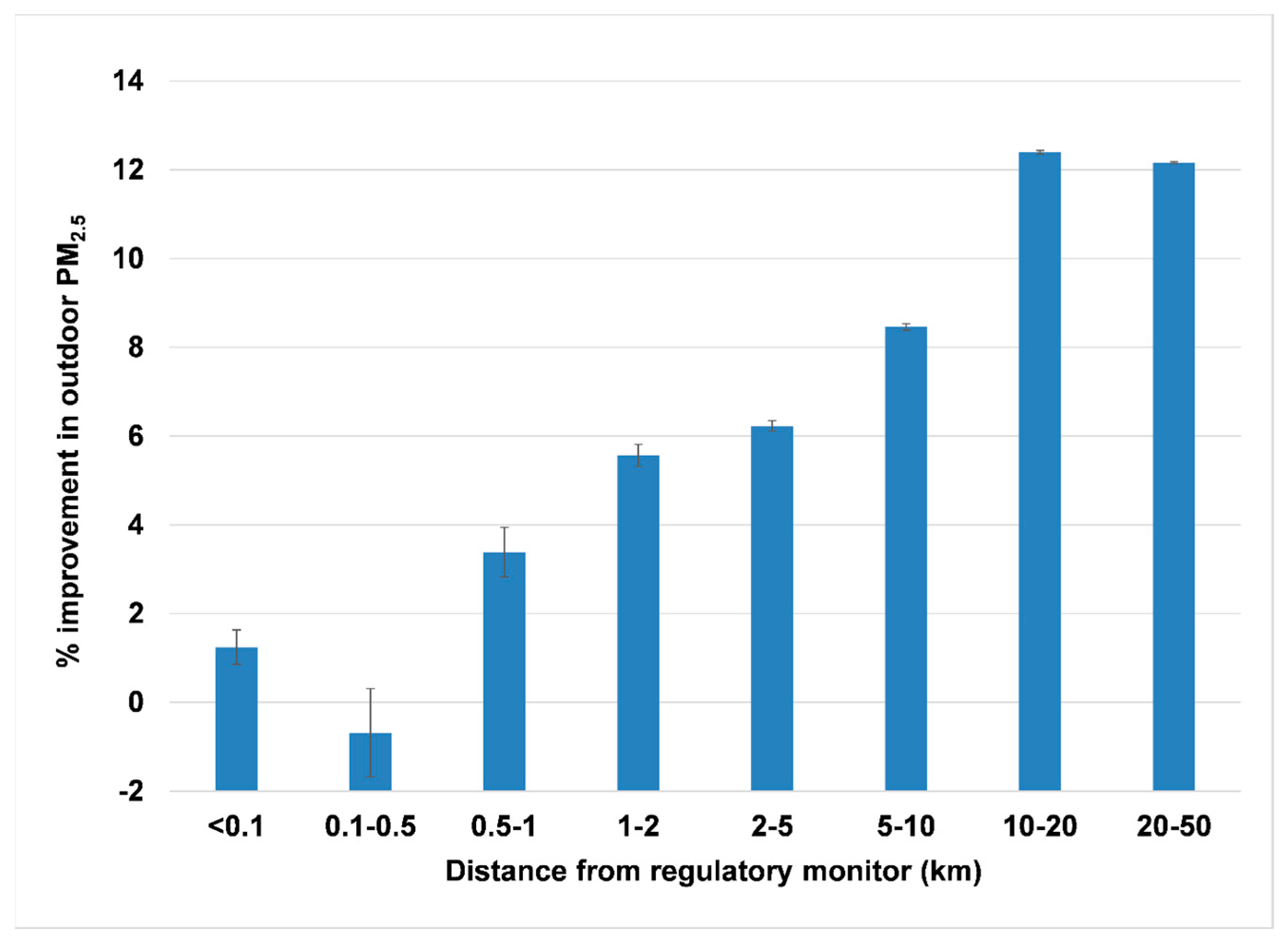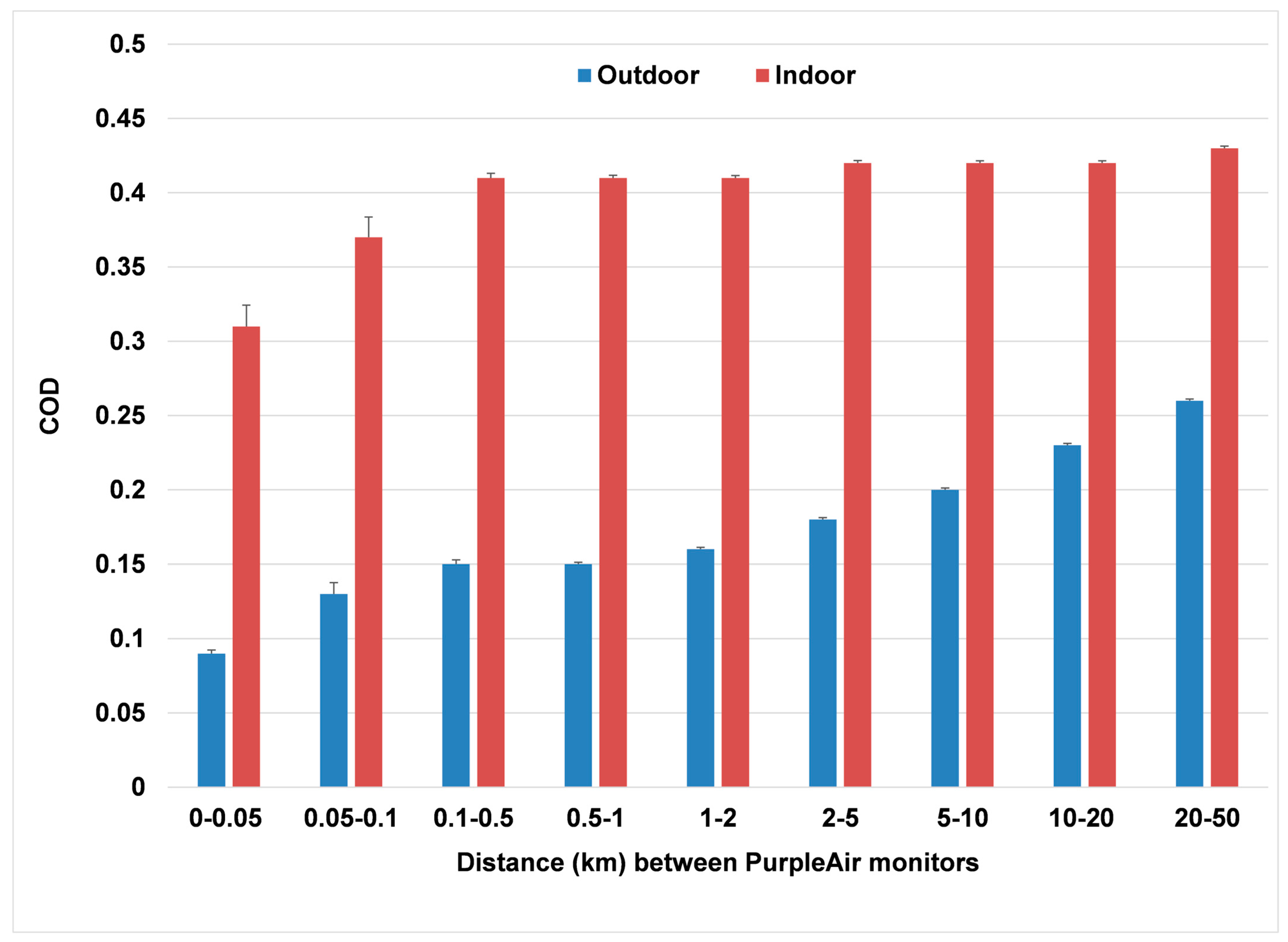Spatial Variation of PM2.5 Indoors and Outdoors: Results from 261 Regulatory Monitors Compared to 14,000 Low-Cost Monitors in Three Western States over 4.7 Years
Abstract
1. Introduction
2. Methods and Materials
2.1. Comparisons with Regulatory Sites
2.2. Intercomparisons of PurpleAir Outdoor-Outdoor and Indoor-Indoor Pairs
2.3. Intercomparison of Regulatory Sites
3. Results
3.1. Comparisons with Regulatory Sites
3.2. Intercomparison of Indoor-Indoor and Outdoor-Outdoor PurpleAir Pairs
3.3. Intercomparison of Regulatory (FRM/FEM) Sites
3.4. Comparison of Collocated FEM and FRM Monitors
4. Discussion
4.1. Comparisons of PurpleAir with Regulatory Sites
4.2. Intercomparisons of PurpleAir Outdoor Sites
4.3. Intercomparisons of PurpleAir Indoor Sites
4.4. Intercomparison of Regulatory Sites
4.5. Future Research
5. Conclusions
Author Contributions
Funding
Institutional Review Board Statement
Informed Consent Statement
Data Availability Statement
Acknowledgments
Conflicts of Interest
References
- Wallace, L.A.; Zhao, T.; Klepeis, N.E. Indoor contribution to PM2.5 exposure using all PurpleAir sites in Washington, Oregon, and California. Indoor Air 2022, 32, 13105. [Google Scholar] [CrossRef]
- Pinto, J.P.; Lefohn, A.S.; Shadwick, D.S. Spatial Variability of PM2.5 in Urban Areas in the United States. J. Air Waste Manag. Assoc. 2004, 54, 440–449. [Google Scholar] [CrossRef]
- Blanchard, C.L.; Carr, E.L.; Collins, J.F.; Smith, T.B.; Lehrman, D.; Michaels, H.M. Spatial representativeness and scales of transport during the 1995 integrated monitoring study in California’s San Joaquin Valley. Atmos. Environ. 1999, 33, 4775–4786. [Google Scholar] [CrossRef]
- Wilson, J.G.; Kingham, S.; Pearce, J.; Sturman, A.P. A review of intraurban variations in particulate air pollution: Implications for epidemiological research. Atmos. Environ. 2005, 39, 6444–6462. [Google Scholar] [CrossRef]
- Turner, J.R.; Allen, D.T. Transport of Atmospheric Fine Particulate Matter: Part 2—Findings from Recent Field Programs on the Intraurban Variability in Fine Particulate Matter. J. Air Waste Manag. 2008, 58, 196–215. [Google Scholar] [CrossRef]
- Barkjohn, K.J.; Bergin, M.H.; Norris, C.; Schauer, J.J.; Zhang, Y.; Black, M.; Hu, M.; Zhang, J. Using Low-cost sensors to Quantify the Effects of Air Filtration on Indoor and Personal Exposure Relevant PM2.5 Concentrations in Beijing, China. Aerosol Air Qual. Res. 2020, 20, 297–313. [Google Scholar] [CrossRef]
- Barkjohn, K.K.; Gantt, B.; Clements, A.L. Development and application of a United States-wide correction for PM2.5 data collected with the PurpleAir sensor. Atmos. Meas. Tech. 2021, 14, 4617–4637. [Google Scholar] [CrossRef]
- Bi, J.; Wallace, L.A.; Sarnat, J.A.; Liu, Y. Characterizing outdoor infiltration and indoor contribution of PM2.5 with citizen-based low-cost monitoring data. Environ. Pollut. 2021, 276, 116763. [Google Scholar] [CrossRef]
- BiiD, J.; Wildani, A.; Chang, H.; Liu, Y. Incorporating Low-Cost Sensor Measurements into High-Resolution PM2.5 Modeling at a Large Spatial Scale. Environ. Sci. Technol. 2020, 54, 2152–2162. [Google Scholar] [CrossRef]
- Delp, W.W.; Singer, B.C. Wildfire smoke adjustment factors for low-cost and professional PM2.5 monitors with optical sensors. Sensors 2020, 20, 3683. [Google Scholar] [CrossRef] [PubMed]
- Holder, A.L.; Mebust, A.K.; Maghran, L.A.; McGown, M.R.; Stewart, K.E.; Vallano, D.M.; Elleman, R.A.; Baker, K.R. Field Evaluation of Low-Cost Particulate Matter Sensors for Measuring Wildfire Smoke. Sensors 2020, 20, 4796. [Google Scholar] [CrossRef] [PubMed]
- Jaffe, D.; Miller, C.; Thompson, K.; Nelson, M.; Finley, B.; Ouimette, J.; Andrews, E. An evaluation of the U.S. EPA’s correction equation for Purple Air Sensor data in smoke, dust and wintertime urban pollution events. Atmos. Meas. Tech. Discuss. 2023, 16, 1311–1322. [Google Scholar] [CrossRef]
- Kelly, K.; Whitaker, J.; Petty, A.; Widmer, C.; Dybwad, A.; Sleeth, D.; Martin, R.; Butterfield, A. Ambient and laboratory evaluation of a low-cost particulate matter sensor. Environ. Pollut. 2017, 221, 491–500. [Google Scholar] [CrossRef]
- Zamora, M.L.; Xiong, F.; Gentner, D.R.; Kerkez, B.; Kohrman-Glaser, J.; Koehler, K. Field and Laboratory Evaluations of the Low-Cost Plantower Particulate Matter Sensor. Environ. Sci. Technol. 2018, 53, 838–849. [Google Scholar] [CrossRef] [PubMed]
- Liang, Y.; Sengupta, D.; Campmier, M.J.; Lunderberg, D.M.; Apte, J.S.; Goldstein, A.H. Wildfire smoke impacts on indoor air quality assessed using crowdsourced data in California. Proc. Natl. Acad. Sci. USA 2021, 118, e2106478118. [Google Scholar] [CrossRef] [PubMed]
- Nilson, B.; Jackson, P.L.; Schiller, C.L.; Parsons, M.T. Development and evaluation of correction models for a low-cost fine particulate matter monitor. Atmos. Meas. Tech. 2022, 15, 3315–3328. [Google Scholar] [CrossRef]
- Robinson, D.L. Accurate, low cost PM2.5 measurements demonstrate the large spatial variation in wood smoke pollution in regional Australia and improve modeling and estimates of health costs. Atmosphere 2020, 11, 856. [Google Scholar] [CrossRef]
- Sayahi, T.; Butterfield, A.; Kelly, K.E. Long-term field evaluation of the Plantower PMS low-cost particulate matter sensors. Environ. Pollut. 2019, 245, 932–940. [Google Scholar] [CrossRef]
- Singer, B.C.; Delp, W.W. Response of consumer and research grade indoor air quality monitors to residential sources of fine particles. Indoor Air 2018, 28, 624–639. [Google Scholar] [CrossRef]
- Tryner, J.; L’Orange, C.; Mehaffy, J.; Miller-Lionberg, D.; Hofstetter, J.C.; Wilson, A.; Volckens, J. Laboratory evaluation of low-cost PurpleAir PM monitors and in-field correction using co-located portable filter samplers. Atmos. Environ. 2020, 220, 117067. [Google Scholar] [CrossRef]
- Tryner, J.; Mehaffy, J.; Miller-Lionberg, D.; Volckens, J. Effects of aerosol type and simulated aging on performance of low-cost PM sensors. J. Aerosol Sci. 2020, 150, 105654. [Google Scholar] [CrossRef]
- Tryner, J.; Quinn, C.; Windom, B.C.; Volckens, J. Design and evaluation of a portable PM2.5 monitor featuring a low-cost sensor in line with an active filter sampler. Environ. Sci. Process. Impacts 2019, 21, 1403–1415. [Google Scholar] [CrossRef]
- Wang, Z.; Delp, W.W.; Singer, B.C. Performance of low-cost indoor air quality monitors for PM2.5 and PM10 from residential sources. Build. Environ. 2020, 171, 106654. [Google Scholar] [CrossRef]
- Zusman, M.; Schumacher, C.S.; Gassett, A.J.; Spalt, E.W.; Austin, E.; Larson, T.V.; Carvlin, G.; Seto, E.; Kaufman, J.D.; Sheppard, L. Calibration of low-cost particulate matter sensors: Model development for a multi-city epidemiological study. Environ. Int. 2020, 134, 105329. [Google Scholar] [CrossRef]
- AQ-SPEC. Field Evaluation Purple Air PM Sensor. 2016. Available online: http://www.aqmd.gov/docs/default-source/aq-spec/field-evaluations/purpleair---field-evaluation.pdf (accessed on 28 April 2023).
- Wallace, L.; Bi, J.; Ott, W.R.; Sarnat, J.A.; Liu, Y. Calibration of low-cost PurpleAir outdoor monitors using an improved method of calculating PM2.5. Atmos. Environ. 2021, 256, 118432. [Google Scholar] [CrossRef]
- Wallace, L.; Zhao, T.; Klepeis, N.E. Calibration of PurpleAir PA-I and PA-II Monitors Using Daily Mean PM2.5 Concentrations Measured in California, Washington, and Oregon from 2017 to 2021. Sensors 2022, 22, 4741. [Google Scholar] [CrossRef]
- Wallace, L. Intercomparison of PurpleAir Sensor Performance over Three Years Indoors and Outdoors at a Home: Bias, Precision, and Limit of Detection Using an Improved Algorithm for Calculating PM2.5. Sensors 2022, 22, 2755. [Google Scholar] [CrossRef] [PubMed]
- Ott, W.; Wallace, L.; Mage, D. Predicting Particulate (PM10) Personal Exposure Distributions Using a Random Component Superposition Statistical Model. J. Air Waste Manag. Assoc. 2000, 50, 1390–1406. [Google Scholar] [CrossRef]




| Distance Category (km) | # Site Pairs | Mean Days Per Site Pair * | FRM/FEM Mean PM2.5 (SE) | PurpleAir Mean PM2.5 (SE) | Pearson Corr. Coeff. (rp) (SE) | Coeff. of Divergence (COD) (SE) |
|---|---|---|---|---|---|---|
| <0.1 | 314 | 338 (21) | 11.7 (0.24) | 11.5 (0.30) | 0.91 (0.006) | 0.24 (0.004) |
| 0.1 to 0.5 | 42 | 247 (35) | 10.6 (0.64) | 10.7 (0.76) | 0.90 (0.018 | 0.24 (0.014) |
| 0.5 to 1 | 84 | 316 (28) | 9.6 (0.34) | 9.3 (0.45) | 0.87 (0.014) | 0.26(0.008) |
| 1 to 2 | 399 | 313 (13) | 10.0 (0.16) | 9.4 (0.19) | 0.87 (0.007) | 0.27 (0.004) |
| 2 to 5 | 2339 | 301 (5.0) | 10.3 (0.07) | 9.7(0.09) | 0.87 (0.003 | 0.27 (0.002) |
| 5 to 10 | 5291 | 297 (3.6) | 10.4 (0.04) | 9.5 (0.06) | 0.85 (0.002) | 0.28 (0.001) |
| 10 to 20 | 14,721 | 301 (2.2) | 10.4 (0.02) | 9.1 (0.03) | 0.81 (0.001) | 0.30 (0.001) |
| 20 to 50 | 59,372 | 305 (1.0) | 10.3 (0.01) | 9.0 (0.02) | 0.76 (o.001) | 0.32 (0.000) |
| Distance | N Pairs | Mean | Median | ||||||
|---|---|---|---|---|---|---|---|---|---|
| rs * | rp * | R2 | CoD | rs | rp | R2 | CoD | ||
| Outdoor | |||||||||
| 0–0.05 km | 868 | 0.97 | 0.97 | 0.95 | 0.09 | 0.99 | 0.998 | 0.996 | 0.07 |
| 0.05–0.1 km | 139 | 0.96 | 0.97 | 0.94 | 0.13 | 0.99 | 0.99 | 0.99 | 0.11 |
| 0.1–0.5 km | 1616 | 0.93 | 0.92 | 0.85 | 0.15 | 0.97 | 0.99 | 0.98 | 0.11 |
| 0.5–1 km | 4302 | 0.92 | 0.93 | 0.85 | 0.15 | 0.96 | 0.98 | 0.93 | 0.15 |
| 1–2 km | 7740 | 0.91 | 0.92 | 0.84 | 0.16 | 0.96 | 0.98 | 0.96 | 0.13 |
| 2–5 km | 7544 | 0.90 | 0.91 | 0.82 | 0.18 | 0.94 | 0.97 | 0.94 | 0.15 |
| 5–10 km | 7591 | 0.88 | 0.89 | 0.79 | 0.20 | 0.92 | 0.95 | 0.89 | 0.18 |
| 10–20 km | 7527 | 0.84 | 0.85 | 0.72 | 0.23 | 0.88 | 0.91 | 0.83 | 0.21 |
| 20–50 km | 7639 | 0.79 | 0.80 | 0.65 | 0.26 | 0.83 | 0.86 | 0.74 | 0.24 |
| Indoor | |||||||||
| 0–0.05 km | 308 | 0.75 | 0.71 | 0.50 | 0.31 | 0.87 | 0.78 | 0.61 | 0.27 |
| 0.05–0.1 km | 247 | 0.61 | 0.57 | 0.32 | 0.37 | 0.64 | 0.60 | 0.36 | 0.36 |
| 0.1–0.5 km | 2249 | 0.55 | 0.48 | 0.23 | 0.41 | 0.56 | 0.47 | 0.22 | 0.38 |
| 0.5–1 km | 4933 | 0.52 | 0.43 | 0.19 | 0.41 | 0.54 | 0.42 | 0.17 | 0.38 |
| 1–2 km | 7332 | 0.51 | 0.42 | 0.18 | 0.41 | 0.53 | 0.41 | 0.17 | 0.39 |
| 2–5 km | 7424 | 0.50 | 0.41 | 0.17 | 0.42 | 0.52 | 0.40 | 0.16 | 0.39 |
| 5–10 km | 7537 | 0.48 | 0.40 | 0.16 | 0.42 | 0.50 | 0.38 | 0.15 | 0.40 |
| 10–20 km | 7508 | 0.47 | 0.38 | 0.15 | 0.42 | 0.49 | 0.37 | 0.14 | 0.40 |
| 20–50 km | 7589 | 0.45 | 0.37 | 0.14 | 0.43 | 0.47 | 0.35 | 0.13 | 0.40 |
| Distance (km) | N Pairs | Mean | Median | ||||||
|---|---|---|---|---|---|---|---|---|---|
| rs * | rp * | R2 | CoD | rs * | rp * | R2 | CoD | ||
| 0 (collocated) | 68 | 0.97 | 0.93 | 0.93 | 0.14 | 0.99 | 0.95 | 0.97 | 0.13 |
| 2 to 5 | 40 | 0.92 | 0.85 | 0.84 | 0.19 | 0.95 | 0.87 | 0.90 | 0.19 |
| 5 to 10 | 56 | 0.91 | 0.86 | 0.83 | 0.17 | 0.95 | 0.92 | 0.90 | 0.14 |
| 10 to 20 | 134 | 0.88 | 0.86 | 0.78 | 0.18 | 0.90 | 0.87 | 0.82 | 0.18 |
| 20 to 50 | 614 | 0.80 | 0.77 | 0.64 | 0.24 | 0.84 | 0.79 | 0.70 | 0.23 |
| 50 to 100 | 1316 | 0.64 | 0.63 | 0.41 | 0.30 | 0.69 | 0.67 | 0.48 | 0.29 |
| 100 to 200 | 3536 | 0.52 | 0.52 | 0.27 | 0.34 | 0.54 | 0.56 | 0.29 | 0.33 |
| # Pairs | # Days Per Site | Mean | Median | |||||||
|---|---|---|---|---|---|---|---|---|---|---|
| rs * | rp * | R2 | CoD | rs * | rp * | R2 | CoD | |||
| FRM-FRM | 23 | 223 | 0.96 | 0.98 | 0.96 | 0.10 | 0.98 | 0.99 | 0.99 | 0.08 |
| FRM-FEM | 36 | 470 | 0.92 | 0.96 | 0.92 | 0.16 | 0.94 | 0.98 | 0.96 | 0.13 |
| FEM-FEM | 9 | 345 | 0.90 | 0.91 | 0.82 | 0.15 | 0.94 | 0.94 | 0.88 | 0.11 |
Disclaimer/Publisher’s Note: The statements, opinions and data contained in all publications are solely those of the individual author(s) and contributor(s) and not of MDPI and/or the editor(s). MDPI and/or the editor(s) disclaim responsibility for any injury to people or property resulting from any ideas, methods, instructions or products referred to in the content. |
© 2023 by the authors. Licensee MDPI, Basel, Switzerland. This article is an open access article distributed under the terms and conditions of the Creative Commons Attribution (CC BY) license (https://creativecommons.org/licenses/by/4.0/).
Share and Cite
Wallace, L.; Zhao, T. Spatial Variation of PM2.5 Indoors and Outdoors: Results from 261 Regulatory Monitors Compared to 14,000 Low-Cost Monitors in Three Western States over 4.7 Years. Sensors 2023, 23, 4387. https://doi.org/10.3390/s23094387
Wallace L, Zhao T. Spatial Variation of PM2.5 Indoors and Outdoors: Results from 261 Regulatory Monitors Compared to 14,000 Low-Cost Monitors in Three Western States over 4.7 Years. Sensors. 2023; 23(9):4387. https://doi.org/10.3390/s23094387
Chicago/Turabian StyleWallace, Lance, and Tongke Zhao. 2023. "Spatial Variation of PM2.5 Indoors and Outdoors: Results from 261 Regulatory Monitors Compared to 14,000 Low-Cost Monitors in Three Western States over 4.7 Years" Sensors 23, no. 9: 4387. https://doi.org/10.3390/s23094387
APA StyleWallace, L., & Zhao, T. (2023). Spatial Variation of PM2.5 Indoors and Outdoors: Results from 261 Regulatory Monitors Compared to 14,000 Low-Cost Monitors in Three Western States over 4.7 Years. Sensors, 23(9), 4387. https://doi.org/10.3390/s23094387






